
* The Aerospatiale company of France became a global player in the helicopter market through its popular "Alouette" series of light helicopters. Following up on this success, in the 1970s the firm developed a series of rotorcraft, including the "Dauphin (Dolphin)" medium helicopter, which proved popular as well and remains in production with Airbus Helicopter, Aerospatiale's successor firm via the earlier Eurocopter firm. This document provides a history and description of the Dauphin family, including its "Panther" military variant, plus the "H175" and "H160" helicopters. A list of illustration credits is included at the end.
* In the late 1960s, the Aerospatiale firm began work on a mid-sized helicopter, with two prototypes built of the "SA 360C", the first performing its initial flight on 2 June 1972. The "SA" designation was a relic left over from Sud Aviation, which had become Aerospatiale through a set of mergers in 1970. The second prototype followed on 29 January 1973, leading to certification in late 1975 and initial customer shipments in early 1976.
The SA 360C had a four-blade main rotor plus a "fenestron" (enclosed fan) tail rotor with 13 blades; twin swept tailfins; and fixed tailwheel landing gear, with the main gear in spats. The first prototype was powered by a single Turbomeca Astazou XVI turboshaft engine providing 730 kW (980 SHP), but it was later refitted with an Astazou XVIIIA producing 785 kW (1,050 SHP), this engine variant being fitted to production machines. The SA 360C had a capacity of up to nine passengers plus the pilot.
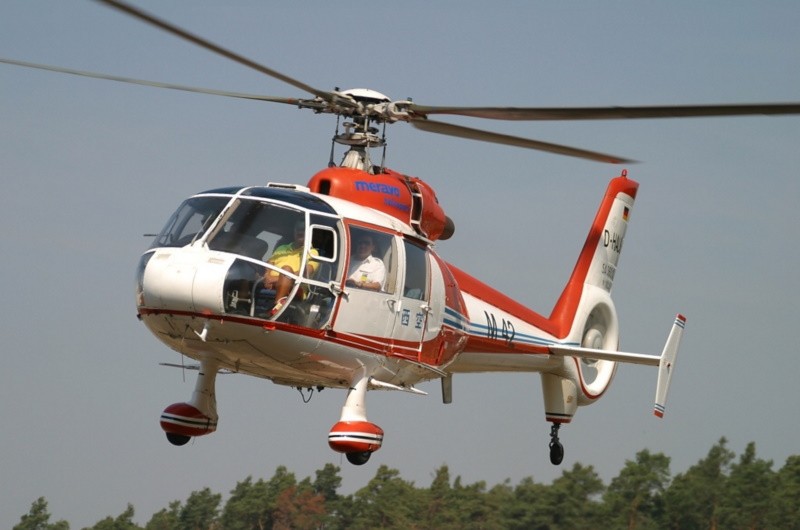
Aerospatiale also decided to develop a militarized version, the "SA 361H", with the "Starflex" rotor hub developed for the Ecureuil light helicopter and powered by an uprated Astazou XXB turboshaft engine with 1,045 kW (1,400 SHP). In the assault transport role, the SA 361H could carry 13 fully-equipped troops. It could also be configured as an anti-armor gunship, carrying eight Euromissile HOT anti-tank missiles; the missiles were aimed by an SFIM APX M397 optical sight on top of the fuselage, with the sight complemented by an SFIM Venus night-vision system mounted on the nose.
* Only one SA 361H was built, with this machine eventually being passed on to the French military for trials use. The military saw a single-engine helicopter as unsatisfactory, and so Aerospatiale decided to rethink the entire product line by switching to twin engines. The result was the "SA 365C Dauphin 2", with initial flight of the prototype on 24 January 1975, powered by twin Turbomeca Arriel 1 turboshaft engines with 485 kW (650 SHP) each. Initial deliveries of production machines, with Arriel 1A engines providing 490 kW (660 SHP), were in early 1978.
The SA 365C was quickly followed by the "SA 365N Dauphin 2", which established the definitive Dauphin configuration. It featured Arriel 1C engines with 530 kW (710 SHP) each; retractable hydraulic tricycle landing gear; increased use of composite materials in the fuselage; and an extended nose for radar. The dynamic system was generally similar to that of its predecessors. It could carry a pilot and 12 passengers in a high density seating arrangement, though more typically there were two seats in front and two rows of four-across seating in back for a total of 8 passengers. VIP configurations could accommodate four or six passengers, with medical service configurations carrying up to four litters plus an attendant. There were three forward-opening doors on each side, with the rear door on medical service machines hinging 180 degrees.
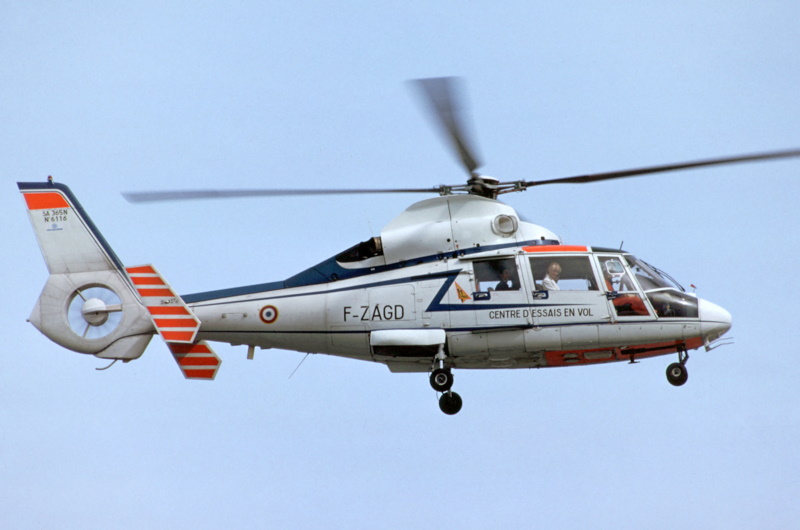
Initial flight of the SA 365N was on 31 March 1979. The SA 365N was followed in turn by refined variants:
___________________________________________________________________
EUROCOPTER SA 365N2 DAUPHIN 2:
___________________________________________________________________
main rotor diameter:
11.94 meters (39 feet 2 inches)
fenestron diameter:
1.1 meters (3 feet 7 inches)
fuselage length:
11.63 meters (38 feet 2 inches)
footprint length:
13.68 meters (44 feet 11 inches)
height (tail):
3.98 meters (13 feet 1 inch)
empty weight:
2,239 kilograms (4,936 pounds)
max loaded weight:
4,250 kilograms (9,370 pounds)
fast cruise speed:
285 KPH (175 MPH / 155 KT)
service ceiling:
4,300 meters (14,100 feet)
range:
900 kilometers (560 MI / 485 NMI)
___________________________________________________________________
BACK_TO_TOP
* In the 1980s, the Dauphin 2 was redesignated "AS 365" -- with "AS" for "Aerospatiale" -- from the earlier "SA 365". A "Dauphin Fly-By-Wire (FBW)" demonstrator was flown in 1989, with another testbed, the "Dauphin X380 Developpement Technique Probatoire" flown in the same year, to be followed by the high-speed "AS 365X Dauphin Grande Vitesse (DGV / Dauphin High Speed)" in 1991. The DGV set a world speed record in its class of 371 KPH (200 KT).
In 1992, the helicopter division of Aerospatiale merged with the German Messerschmitt-Boelkow-Blohm firm to form "Eurocopter", which would later become part of the "European Aerospace & Defense Systems (EADS)" group. The Dauphin 2 became part of the Eurocopter line. Under the new organization, the advanced technology work on the Dauphin led to the conversion of the DGV into a prototype of the next-generation "AS 365N4", with initial flight on 17 June 1997. The type was then redesignated "Eurocopter France EC 155", with initial flight of a production standard machine on 11 March 1998. Certifications were awarded in late 1998, with production deliveries of the "EC 155B" following.
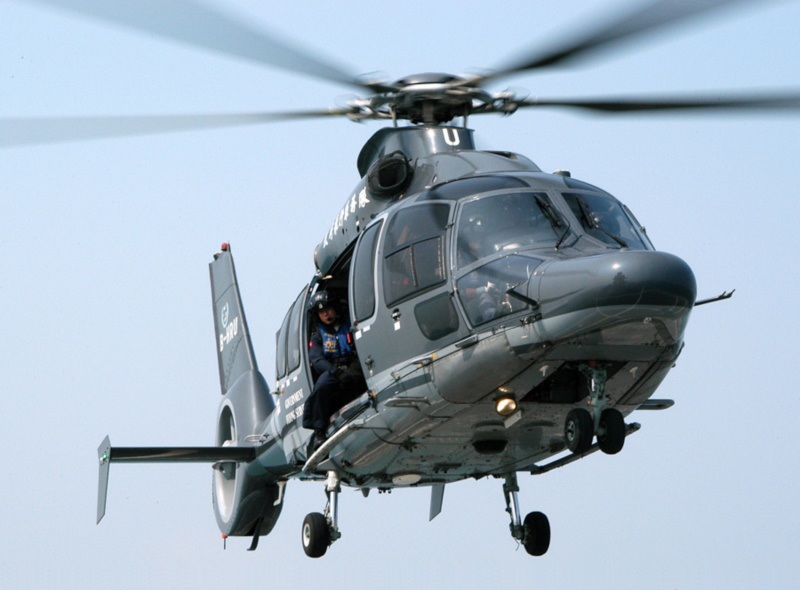
The EC 155B featured bulged doors, along with rearranged cabin space and revised window layout; a five-blade rotor with a new dynamic system, featuring a carbon-composite "Spheriflex" rotor head; a 10-blade fenestron tail rotor, with the blades unequally spaced to reduce noise; and a glass cockpit. It was powered by twin Arriel 2C1 turboshafts with 635 kW (850 SHP) take-off power each. It could carry a pilot and up to 14 passengers in a high density arrangement; four to eight passengers in VIP arrangements; and six stretchers in a medical evacuation arrangement. Maximum sling load was 1,600 kilograms (3,525 pounds).
___________________________________________________________________
AIRBUS EC 155B1:
___________________________________________________________________
main rotor diameter:
12.6 meters (41 feet 4 inches)
fenestron diameter:
1.1 meters (3 feet 7 inches)
fuselage length:
12.71 meters (41 feet 8 inches)
footprint length:
14.3 meters (46 feet 11 inches)
height (tail):
4.35 meters (13 feet 3 inches)
empty weight:
2,615 kilograms (5,765 pounds)
max loaded weight:
4,920 kilograms (10,847 pounds)
fast cruise speed:
265 KPH (165 MPH / 145 KT)
service ceiling:
4,570 meters (15,000 feet)
range (no aux tank):
785 kilometers (485 MI / 425 NMI)
___________________________________________________________________
An improved "EC 155B1" replaced the EC 155B in production in 2002. It featured various minor refinements, such as new engine cowlings and jettisonable cockpit doors, as well as Arriel 2C2 engines with FADEC and 700 kW (935 SHP) take-off power. Eurocopter also flew an "EC 155 HTT (Helicoptere Tous Temps / Helicopter All Weather)" demonstrator with a digital terrain map and avoidance system, along with a modernized glass cockpit. In 2010, the company introduced a new feature in the EC 155, the "Blue Edge Blade", a "kinked" rotor blade with "double sweep" that provided a substantial decrease in noise.
In 2014, EADS became the "Airbus Group", and Eurocopter became "Airbus Helicopters". The company continued to enhance the Dauphin product line, introduced in 2014 an "AS 365N3e" -- the "e" meaning "enhanced" -- with Arriel 2N engines, providing 15% more power and a 200-kilogram (440-pound) increment to maximum take-off weight. However, that was the last of the line for Airbus, with final production of the series in 2021.
* Airbus Helicopters collaborated with Korea Aerospace Industries (KAI) to adapt the EC 155 as the "Light Armed Helicopter (LAH)" for the Republic of Korea Army, to replace elderly Hughes 500 Defender scouts and Bell AH-1F Cobra gunships. Initial flight of the first of three LAH prototypes was in July 2019.
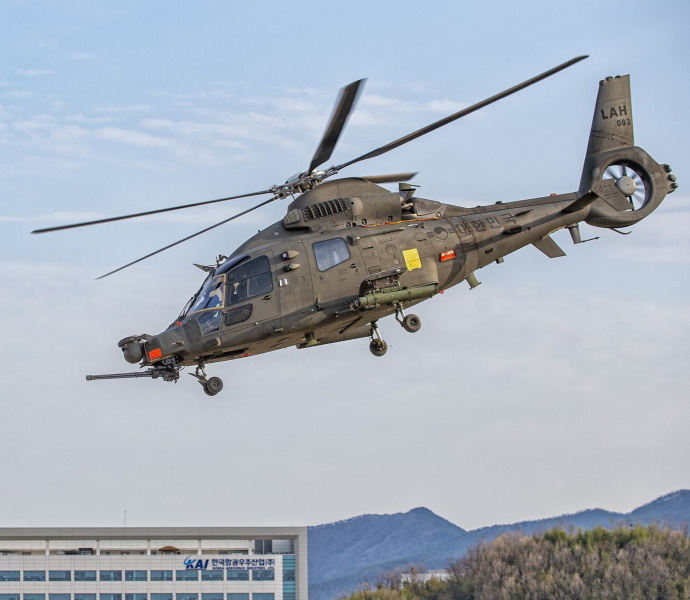
As introduced, the LAH featured:
Initial delivery was at the end of 2024, with about 210 LAHs to be obtained. A "Light Utility Helicopter (LUH)" variant is also being developed, being an LAH intended for carrying special forces troops and featuring external benches. A drone version is under consideration, though it hasn't flown yet.
BACK_TO_TOP* Early on in Dauphin 2 development a modified variant, the "SA 366G1", was offered in response to a requirement by the US Coast Guard (USCG) for a maritime rescue helicopter. The SA 366G1 won the contest, with the variant going into USCG services as the "HH-65A Dolphin". Initial flight of the first HH-65A, in France, was on 23 July 1980, with first formal delivery of an HH-65A on 1 February 1987. The Coast Guard acquired a fleet of 102 machines.
The HH-65A outwardly resembled a standard Dauphin 2, but it featured a number of changes, most notably fit of two Textron Lycoming LTS101-750A-1 turboshafts with 505 kW (680 SHP) each. The engine fit was clearly less powerful than that of the SA 365, and the selection would prove troublesome. Other features were:
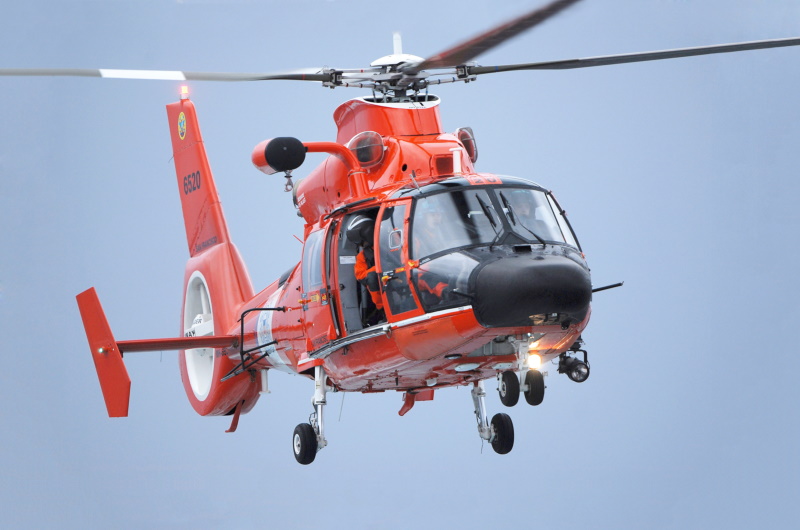
The Israeli Navy obtained two HH-65A developmental machines in 1985, at least initially on an evaluation basis, with one lost in a fatal crash in 1996 and the other retired a year later. There have been no other foreign users of the HH-65.
From 2001, the HH-65A fleet was upgraded to "HH-65B" configuration, with a Global Positioning System (GPS) navigation receiver and twin flat-panel displays. This effort ended up paving the way for a more substantial upgrade. Aircrews were never very happy about the LTS101 powerplants, which were not powerful enough from the start, and eventually proved unreliable as well. A Dolphin with Turbomeca Arriel turboshafts performed its first flight in late 2002 as part of an evaluation of the alternate powerplants.
That led to a fast-track program initiated in early 2003 to fit all 96 machines in the USCG HH-65 fleet with twin Turbomeca Arriel 2C2 turboshafts, providing 780 kW (1,054 SHP) each. The upgraded machines are designated "HH-65C". A number of these were fitted with 10-blade low-noise fenestrons, replacing the standard 11-blade fans, with avionics shuffled around a bit, and support provided for armament -- an M240 MAG 7.62-millimeter machine gun and a Barrett Fifty 12.7-millimeter anti-materiel rifle. These armed machines are designated "MH-65C".
From 2011, the HH/MH-65 fleet was upgraded to "MH-65D" specification, featuring an upgraded flight navigation system common to US Department of Defense helicopters, with a Honeywell radar altimeter and PS / inertial navigation system, plus two associated Rockwell Collins displays. The "MH" designation suggests they are all capable of being armed.
A further upgrade was conducted, to "MH-65E" standard, built around a "Common Avionics Architecture System (CAAS)", providing compatibility with the USCG MH-60T Jayhawk, and featuring a four-display "glass cockpit". The MH-65E also featured a new radar, flight control system, and traffic collision avoidance system (TCAS). Initial flight of an MH-65E was in 2015, with initial redelivery in 2019 and final delivery in 2024.
* The HH-65 was effectively a semi-militarized Dauphin 2; unsurprisingly, specifically military versions of the Dauphin 2 were offered as well. There was a naval variant and an army variant, originally designated the "SA 365F" and "SA 365M" respectively, with the military branch of the family was eventually being given the overall designation of "AS 565 Panther". New design features included:
The prototype of the naval variant, a modified SA 365N, performed its initial flight on 22 February 1982, to be followed by the first production SA 365F machine on 2 July 1982. The naval variant was originally powered by twin Turbomeca Arriel 1M turboshafts providing 520 kW (700 SHP) each. Two subvariants were offered:
From 1997, the AS 565SA/MA was replaced in production by the "AS 565SB/MB", featuring various refinements, most notably Arriel 2C turboshafts. The French Navy obtained 18 AS 565SA machines.
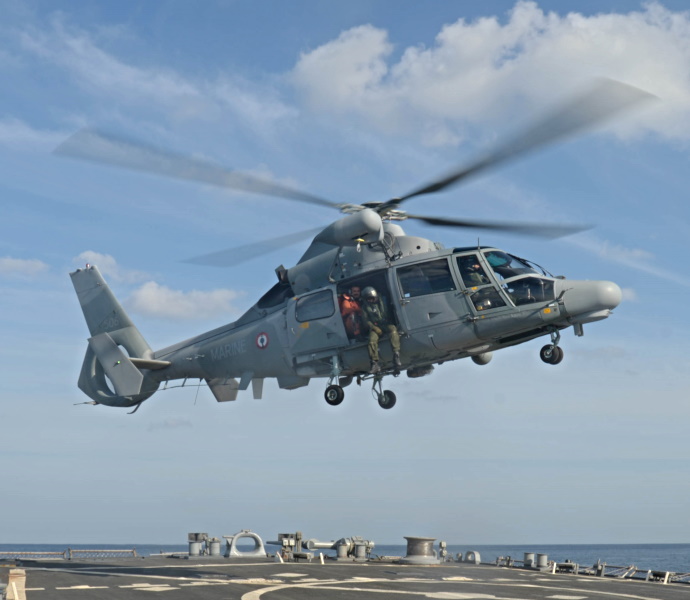
An "AS 565MBe" was introduced, with Arriel 2N engines, providing 840 kW (1,130 SHP) for improved "hot & high" performance, plus modernized avionics. The Mexican Navy was the launch customer. In 2009, the French Navy began a program to upgrade their existing Panther helicopters to a "Mark 2" configuration. Changes included:
Redeliveries were from 2011. The upgrade paved the way for carriage of the MBDA "Sea Venom" AKA "Anti-Navire Legere (ANL / anti-ship light)" anti-ship missile, which replaced the AS-15TT.
* The prototype of the SA 365M army variant performed its first flight on 29 February 1984; it was followed in April 1986 by an improved prototype, the "SA 365K", which introduced the "Panther" name to the series. It was powered by twin Turbomeca Arriel 1M1 turboshafts with FADEC and 560 kW (750 SHP) take-off power each. Three subvariants were offered:
From 1997, the product line was updated to the "AS 565UB", "AS 565CB", and "AS 565AB" respectively, with various refinements and Arriel 2C turboshafts with 635 kW (850 SHP) take-off power each. An "AS 565 Panther 800" demonstrator was flown in 1992, featuring twin LHTEC T800 turboshafts and an IBM-integrated avionics suite, the target customer being the US Army. There was no serious interest, and the variant never entered production.
* The Dauphin and Panther series have been widely exported. Along with civil sales, government users have included: Australia, Argentina, Djibouti, Greece, Iceland, Indonesia, Japan, Kuwait, Lithuania, Malaysia, the Netherlands, Spain, Sweden, and Taiwan, with operating organizations including police / border patrol, search & rescue groups, and fire departments.
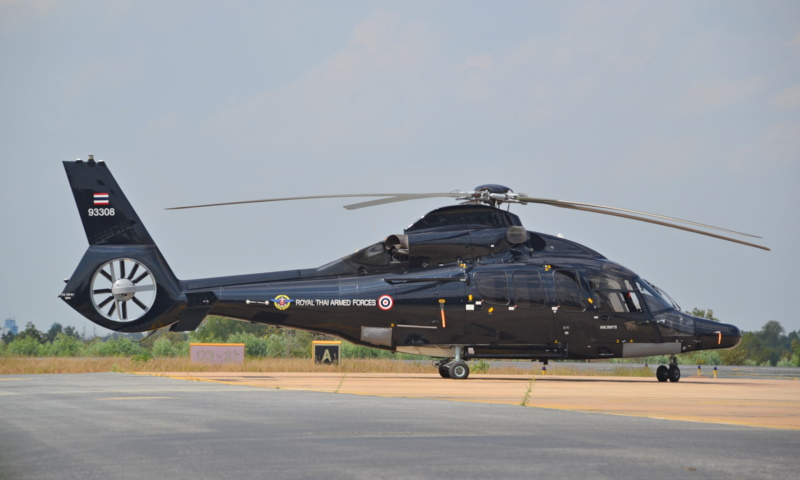
Foreign military operators of the Panther have included Abu Dhabi, Brazil, Bulgaria, Chile, Indonesia, Ireland, Israel, Mexico, Morocco, Saudi Arabia, South Korea, Saudi Arabia, Thailand, Turkmenistan, and the United Arab Emirates. Saudi Panthers saw combat in the 1st Gulf War, firing AS-15TT antiship missiles at Iraqi patrol boats. There have been upgrades of machines in service, featuring engine and avionics updates.
BACK_TO_TOP* The following list summarizes Dolphin / Panther variants:
* The Dauphin 2 family is license-built in China by Harbin / HAI as the "Z-9", with the initial production variant being the AS 365N1, assembled from French-supplied kits. It was followed by the "Z-9A", which was the AS 365N2 built from kits; the "Z-9B", which was the same but built locally; the "Z-9C", a naval variant, capable of hauling two torpedoes or antiship missiles; and the "WZ-9", which was an anti-armor variant, with a sight above the cockpit and carriage of eight anti-armor missiles or other munitions.
The Z-9 series has been further refined, though it's hard to nail down the specifics. An "H410A" was introduced in 2001, featuring WZ8C / Arriel 2C engines, to be then followed by an "H425" with a glass cockpit; and most recently a modernized "AC312" series. Some sources also indicate that Dauphin 2 machines are assembled in Brazil by Helibras, but details are unclear.
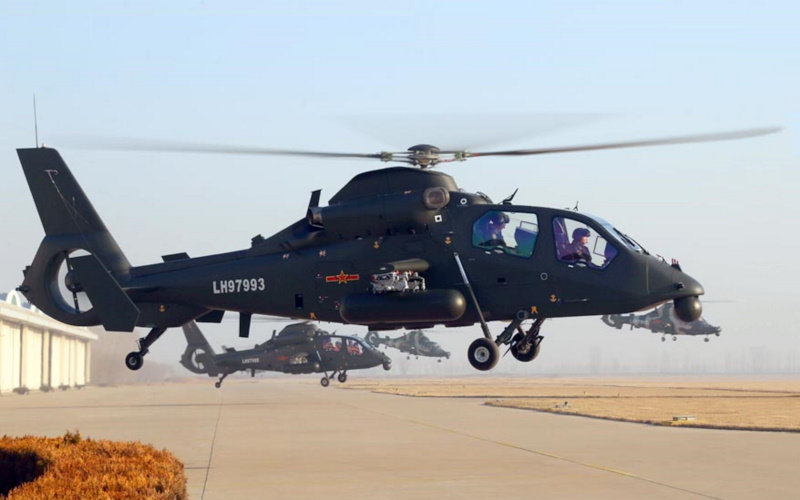
The Chinese Harbin organization has developed a helicopter gunship, the Harbin "Z-19", derived from the Z-9 / AS 365. The Z-19 was named the "Hei Xuan Feng (Black Whirlwind)", from a character in classic Chinese novel WATER MARGIN. As introduced, the Z-19 was about the size of, and comparable to, the Airbus Helicopter Tiger gunship. The Z-19 retained the engine and dynamic system of the Z-9, and a tailboom with the distinctive fenestron tail fan scheme; but had a new forward fuselage with a tandem cockpit. The Z-19 also had an undernose sensor-targeting turret, but did not have a gun turret, clearly relying on stub wing stores instead. Photos have been released of the Z-19 fitted with a drum radome above the main rotor for a millimeter-wave targeting radar. An export version, the "Z-19E", performed its initial flight in 2017.
BACK_TO_TOP* Airbus Helicopters worked with Avicopter of China to develop a new helicopter, the "H175", previously the "EC 175", a 7-tonne (7.7-ton) machine in the size range between the Super Puma and the Dauphin, intended to compete against the comparable Leonardo AW 139.
As introduced, the H175 was a twin-engine machine of conventional main-tail rotor configuration, with a five-blade main rotor. It was powered by dual PWC PT6-76E turboshafts with FADEC, providing 1,490 kW (2,000 SHP) each, and features a glass cockpit with four color multifunction displays (MFD). Avionics were derived from the EC 255 Super Puma+. In a passenger configuration, it provided seating for 16, with a sliding passenger door and crew door on each side.
The program was initiated in 2005. Maiden flight of the first prototype was at Marignane on 4 December 2009, with pilot Alain Di Bianca at the controls. Two more prototypes were built by the Avicopter plant in Harbin. Avicopter, a subsidiary of the Chinese Avic group, is a partner in the H175 program. Initial flight of the first production H175 was in late 2012, with certification following in 2013.
The Chinese produce the H175 as the "AC352", originally the "Z-15". These machines are powered by the Safran Ardiden 3C turboshaft, designated "WZ16" in China, and rated for greater take-off weights. A militarized "H175M" is on offer, but so far nobody has ordered it.
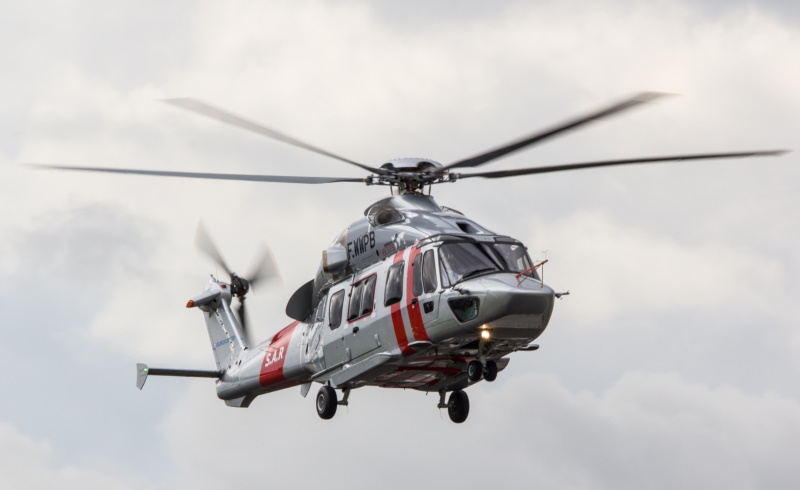
* Airbus Helicopters is also working on next-generation rotorcraft. In the summer of 2010, the firm unveiled a new experimental prototype of a "compound helicopter", described as "High-speed Hybrid Helicopter (H3)" and designated "X3" or "X-Cube". The X-Cube program was initiated in early 2008, with the demonstrator performing its first flight at the French flight test center at Istres on 6 September 2010.
The X-Cube was built around the airframe of the AS 365, using the main rotor of the EC 155 and the gearbox developed for the H175. It was powered by twin Rolls-Turbomeca RTM322 turboshafts providing 1,695 kW (2,270 SHP) each. It featured small down-angled stub wings on each side, with each of the two turboshaft engines driving a tractor-mounted prop at the end of each stub wing. The stub wings unloaded the rotor in forward flight, permitting higher speeds; differential rotation of the props was used in hover to cancel main rotor torque, and so the fenestron tail rotor was deleted. The X-Cube was expected to be able to cruise at speeds of at least 410 KPH (255 MPH / 220 KT). It was not intended to be a production design, simply a technology demonstrator for a high-speed rotorcraft suitable for time-critical missions such as combat SAR.
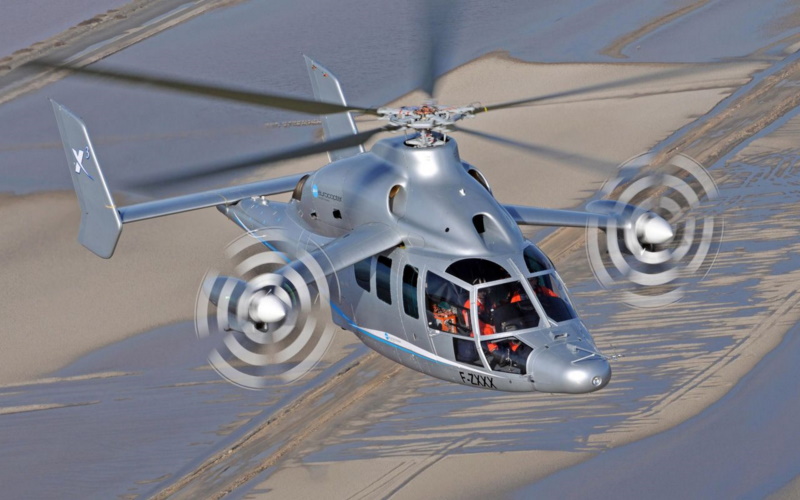
Airbus Helicopters followed up the X3 with a refined design, the "Rapid And Cost-Effective Rotorcraft (RACER)", revealed in 2017. RACER was built as a demonstrator for the European Clean Sky 2 program, intended to promote a range of next-generation aircraft with high fuel efficiency. RACER was of similar configuration to X3 but bigger, and also had "joined wings" -- like biplane wings, but joined at the tip -- instead of stub wings. The lower wing stowed the main landing gear. The engines were also switched to pusher configuration, possibly for safety reasons. It was fitted with a standard H175 rotor.
The demonstrator, powered by the Safran RTM322, flew in 2024. It has a flight "eco-mode" that allows one engine to be shut down, even in high-speed cruise. Despite cruise speed 50% greater than a traditional helicopter, the RACER has lower overall fuel consumption than that of a traditional helicopter of comparable size.
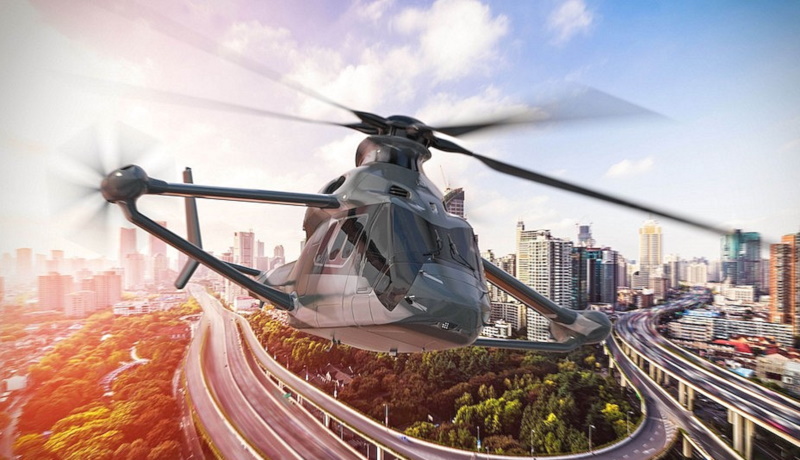
* Airbus Helicopters has also developed a conventional next-generation helicopter, the "H160", originally the "X4", a medium-twin machine to replace the Dauphin series. Specifics were released in 2015, with initial flight of the first of three prototypes on 18 June of that year. The first production machine was rolled out in late 2018, with initial flight on 14 December.
The H160 was intended to compete with the Leonardo AW139, as well as the Sikorsky S-76 and Bell 412, with a particular focus on oil and gas support mission, SAR operators, the emergency medical service community, plus corporate and VIP transport customers. As introduced, the H160 had a maximum take-off weight of up to six tonnes (6.6 tons) and could haul a dozen passengers. The company claimed it had significantly better fuel efficiency and lower operating costs than the AW109.
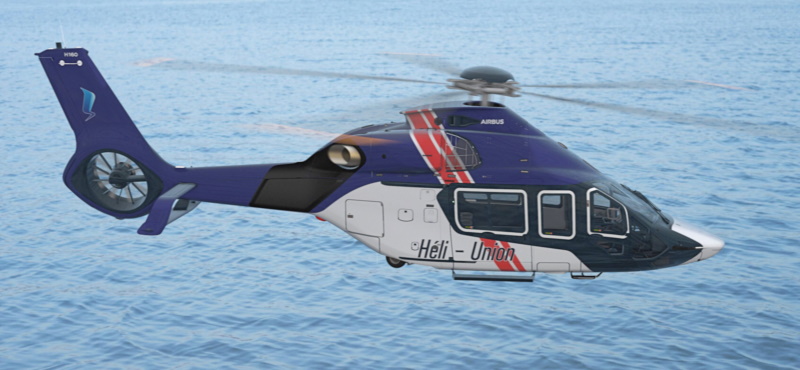
The H160 was largely made of lightweight composites to reduce weight. It was modularly designed, both for ease of manufacturing and flexibility of configuration. It had a fenestron tail fan and a streamlined spheriflex rotor head, with five composite Blue Edge blades featuring "hockey stick" tips; the blades reduced noise and improve efficiency. The fenestron was canted 12 degrees, improving lift performance. Powerplants were twin Turbomeca Arrano turboshafts with 970 kW (1,300 SHP) each, driving the rotor system through a simplified gearbox. The tailplane was in a biplane configuration, increasing low-speed controllability. Landing gear actuation and braking was via electrical, not hydraulic, systems.
The cockpit was fitted with the "Helionix" avionics suite, which was previously installed on the company's EC 145 T2 and EC 175 helicopters; it featured four multifunction displays with touch capability. A Health & Usage Monitoring System (HUMS) was provided, with data transferred wireless for on-the-spot checks. Since HUMS requirements varied with mission and configuration, it was offered as a menu of possible options.
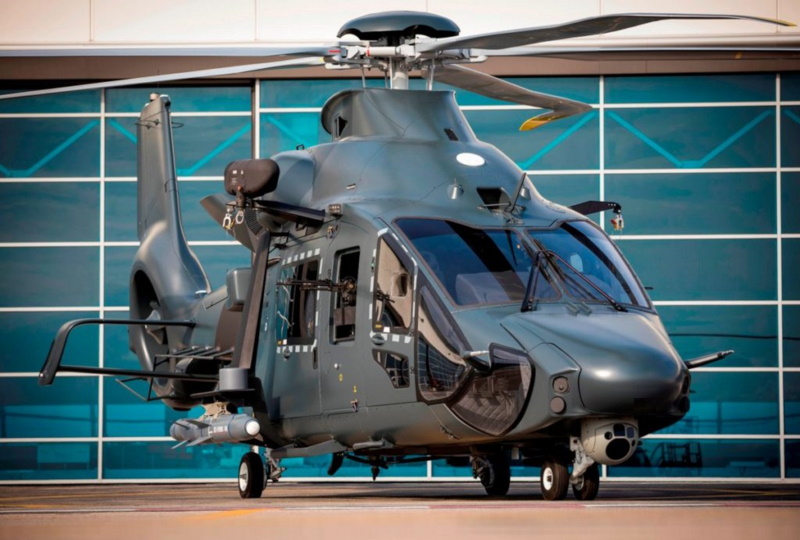
Airbus Helicopters has developed a military variant, the "H160M". The French government selected it for the "Helicoptere Interarmees Leger (HIL / Light Joint Helicopter) requirement in 2017, with introduction to service of the HIL / H160M -- to be named "Guepard (Cheetah)" -- slated for 2026. 169 will be obtained, including 80 for the French Army, 49 for the Navy, and 40 for the Aerospace Force.
BACK_TO_TOP* Helicopters are not over-documented, and so this write-up was put together by scanning through all the JANE'S ALL THE WORLD AIRCRAFT volumes I could find that mentioned these machines, as well as searches of the internet for useful clues. This document originally covered both the Dauphin and the Ecureuil, but it got too long and complicated, so I had to split them into separate documents.
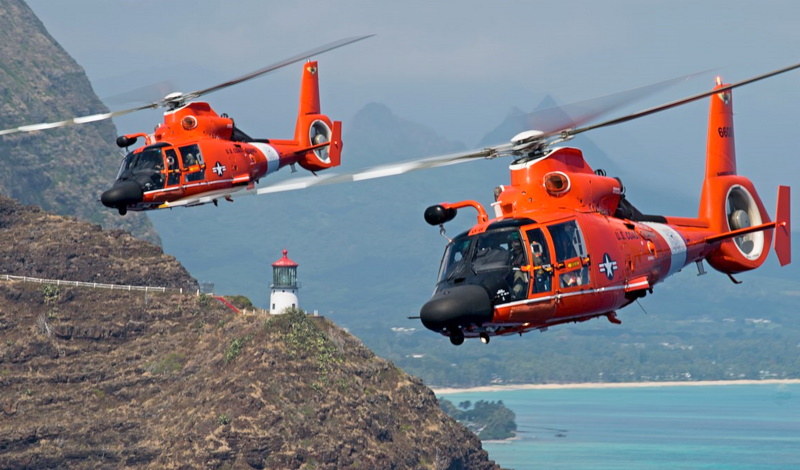
* Illustrations credits:
* Revision history:
v1.0.0 / 01 oct 09 / Initial writeup with both Ecureuil & Dauphin. v1.0.1 / 01 may 10 / Minor update. v2.0.0 / 01 feb 11 / Cut out Ecureuil, added H175 & X-Cube. v2.0.1 / 01 dec 11 / Review & polish. v2.0.2 / 01 nov 13 / Review & polish. v2.1.0 / 01 oct 15 / More on new variants and follow-ons. v2.2.0 / 01 sep 17 / Updates, detuned export user list. v2.3.0 / 01 aug 19 / Review, update, & polish. v2.4.0 / 01 aug 21 / Illustrations update. v2.4.1 / 01 aug 23 / Review, update, & polish. v2.4.2 / 01 sep 25 / Review, update, & polish. (!)BACK_TO_TOP
